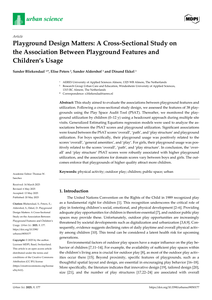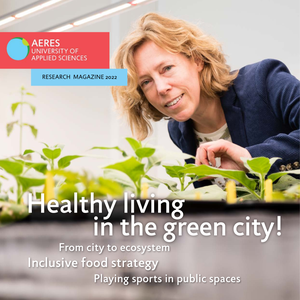Background: The aim of the study was to test the 12-month effects of a multicomponent physical activity (PA) intervention at schoolyards on morning recess PA levels of sixth- and seventh-grade children in primary schools, using accelerometry and additional global positioning system data. Methods: A quasi-experimental study design was used with 20 paired intervention and control schools. Global positioning system confirmatory analyses were applied to validate attendance at schoolyards during recess. Accelerometer data from 376 children from 7 pairs of schools were included in the final analyses. Pooled intervention effectiveness was tested by multilevel linear regression analyses, whereas effectiveness of intervention components was tested by multivariate linear regression analyses. Results: Children exposed to the multicomponent intervention increased their time spent in light PA (+5.9%) during recess. No pooled effects on moderate to vigorous PA were found. In-depth analyses of intervention components showed that physical schoolyard interventions particularly predicted a decrease in time spent in sedentary behavior during recess at follow-up. Intervention intensity and the school’s commitment to the project strengthened this effect. Conclusions: The multicomponent schoolyard PA intervention was effective in making children spend a larger proportion of recess time in light PA, which was most likely the result of a shift from sedentary behavior to light PA.
LINK
Background: The worldwide increase in the rates of childhood overweight and physical inactivity requires successful prevention and intervention programs for children. The aim of the Active Living project is to increase physical activity and decrease sedentary behavior of Dutch primary school children by developing and implementing tailored, multicomponent interventions at and around schools. Methods/design: In this project, school-centered interventions have been developed at 10 schools in the south of the Netherlands, using a combined top-down and bottom-up approach in which a research unit and a practice unit continuously interact. The interventions consist of a combination of physical and social interventions tailored to local needs of intervention schools. The process and short- and long-term effectiveness of the interventions will be evaluated using a quasi-experimental study design in which 10 intervention schools are matched with 10 control schools. Baseline and follow-up measurements (after 12 and 24 months) have been conducted in grades 6 and 7 and included accelerometry, GPS, and questionnaires. Primary outcome of the Active Living study is the change in physical activity levels, i.e. sedentary behavior (SB), light physical activity (LPA), moderate-to-vigorous physical activity (MVPA), and counts-per-minute (CPM). Multilevel regression analyses will be used to assess the effectiveness of isolated and combined physical and social interventions on children’s PA levels. Discussion: The current intervention study is unique in its combined approach of physical and social environmental PA interventions both at school(yard)s as well as in the local neighborhood around the schools. The strength of the study lies in the quasi-experimental design including objective measurement techniques, i.e. accelerometry and GPS, combined with more subjective techniques, i.e. questionnaires, implementation logbooks, and neighborhood observations. LinkedIn: https://www.linkedin.com/in/sanned/
DOCUMENT

DOCUMENT
Veel activiteiten die je binnen doet, kun je ook buiten doen. Denk aan het spelen in hoeken en het aanbieden van activiteiten. Het unieke aan de buitenruimte is dat er meer ruimte is, waardoor groot en veelzijdig bewegen makkelijker wordt, waardoor kinderen andere ervaringen op doen.
MULTIFILE
More and more municipalities are, fortunately, working on play-friendly public spaces. However, many policy visions and investments are still based on assumptions made by municipal officials or suppliers of play equipment.
LINK
Through a correspondence between two scholars, this paper explores and critiques various ways in which scholars working in ethnography and cultural analysis frame and construct their methodology and object of study. Through the close reading of theoretical accounts of methodology in ethnography and cultural analysis, we examine how these accounts construct the relationship between the scholar and her object of study.We read these scholarly practices as protocols, referring to the ways in which accounts of methodology may be understood as rules/guidelines by which scholars in these fields conduct research. Protocol etymologically refers to protos (first) and kolla (glue). Through the figure of the protocol, we delineate how scholars in ethnography and cultural analysis themselves become implicated in giving accounts of their research methodologies. Somatechnics presents a thoroughly multi-disciplinary scholarship on the body, providing a space for research that critically engages with the ethico-political implications of a wide range of practices and techniques. The term ‘somatechnics’ indicates an approach to corporeality which considers it as always already bound up with a variety of technologies, techniques and technics, thus enabling an examination of the lived experiences engendered within a given context, and the effects that technologies, technés and techniques have on embodiment, subjectivity and sociality.
MULTIFILE

This study aimed to evaluate the associations between playground features andutilization. Researchers assessed the features of 38 playgrounds using the Play Space Audit Tool (PSAT). They monitored how children (0–12 y) used the playground. The associations between the PSAT scores and playground utilization were analysed. Significant associations were found between the PSAT scores ‘overall’, ‘path’, and ‘play structure’ and playground utilization. For boys specifically, their playground usage was positively related to the scores ‘overall’, ‘general amenities’, and ‘play’. For girls, their playground usage was positively related to the scores ‘overall’, ‘path’, and ‘play structure’. In conclusion, the ‘overall’ and ‘play structure’ PSAT scores were robustly associated with higher playground utilization, and the associations for domain scores vary between boys and girls. The outcomes enforce that playgrounds of higher quality attract more children. Keywords: physical activity; outdoor play; children; public space; urban
DOCUMENT

Dit onderzoek richt zich op de mate waarin docenten van de opleiding Leisure & Events Management (LEM) van NHL Stenden hogeschool buitenonderwijs toepassen en welke barrières en motiverende factoren zij hierbij ervaren. Buitenonderwijs wordt steeds vaker gezien als een manier om de leerprestaties te verbeteren, stress te verminderen en sociale cohesie te bevorderen. Dit onderzoek speelt in op de vraag hoe buitenonderwijs kan bijdragen aan deze doelen en wat docenten belemmert of motiveert bij het implementeren ervan. De hypothese was dat minder dan de helft van de docenten ervaring zou hebben met buitenonderwijs en dat docenten met ervaring minder barrières en sterkere motivatiefactoren zouden ervaren dan hun onervaren collega's. De conclusie is dat hoewel de meeste docenten al ervaring hebben met buitenonderwijs, de implementatie ervan beperkt blijft door verschillende barrières, met name de fysieke en organisatorische aspecten. Desondanks blijven de motiverende factoren, zoals het verbeteren van de gezondheid en betrokkenheid van studenten, een sterke drijfveer voor docenten om buitenonderwijs te blijven gebruiken. De verschillen tussen ervaren en onervaren docenten zijn niet significant.
DOCUMENT

The aim of the current study was to examine the effectiveness of a school-centered multicomponent PA intervention, called ‘Active Living’, on children's daily PA levels. A quasi-experimental design was used including 9 intervention schools and 9 matched control schools located in the Netherlands. The baseline measurement took place between March–June 2013, and follow-up measurements were conducted 12 months afterwards. Accelerometer (ActiGraph, GT3X +) data of 520 children aged 8–11 years were collected and supplemented with demographics and weather conditions data. Implementation magnitude of the interventions was measured by keeping logbooks on the number of implemented physical environmental interventions (PEIs) and social environmental interventions (SEIs). Multilevel multivariate linear regression analyses were used to study changes in sedentary behavior (SB), light physical activity (LPA) and moderate-to-vigorous physical activity (MVPA) between baseline and follow-up. Finally, effect sizes (ESs) were calculated using Cohen's d. No pooled effects on PA and SB were found between children exposed and not exposed to Active Living after 12 months. However, children attending Active Living schools that implemented larger numbers of both PEIs and SEIs engaged in 15 more minutes of LPA per weekday at follow-up than children in the control condition (ES = 0.41; p < .05). Moreover, children attending these schools spent less time in SB at follow-up (ES = 0.33), although this effect was non-significant. No significant effects were found on MVPA. A school-centered multicomponent PA intervention holds the potential to activate children, but a comprehensive set of intervention elements with a sufficient magnitude is necessary to achieve at least moderate effect sizes.
MULTIFILE

With the beautiful new building of Aeres University of Applied Sciences Almere in the Floriade park, we have materialized our wish to lead the way in the green transition and its challenges. We want to be green changemakers and have the ambition to take on the challenges that we are faced with in agriculture, food and healthy living environments. We bring this about with our study programmes and increasingly with our Practice-Based Research Team. In 10 years’ time, this team has grown from our first professorship into a mature team of 20 people, of whom 7 are research professors.In this edition, three of our new professors will be introduced to you.
DOCUMENT
